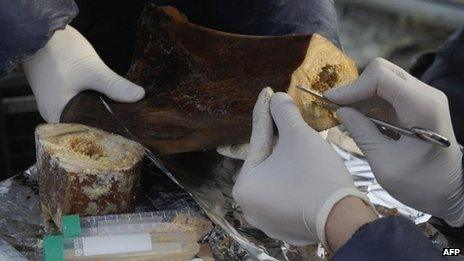Arctic hunt finds mammoth remains
- Published
- comments

The mammoth remains were retrieved from a tunnel dug into the permafrost
A Russian-led expedition has found what it says are well preserved mammoth remains in Siberia but has downplayed reports that the material could be used to clone the ancient beast.
The skin and bone were recovered from a tunnel dug into the permafrost in the Ust-Yansk area of the Yakutia region on Russia's Arctic coast.
The team hopes to find intact DNA that can be used to reproduce the creature.
But a member of the group told Reuters news agency this was doubtful.
"We are counting on our region's permafrost to have kept some cells alive. But it is unlikely," said Semyon Grigoryev, a professor at North-East Federal University (NEFU).
Most of the scientific community is highly sceptical that any mammoth cloning project could succeed. Genetic material still present in ancient remains would be so degraded as to make the task impracticable, experts say.
Mammoths first appeared in the Pliocene Epoch, 4.8 million years ago.
What caused their widespread disappearance at the end of the last Ice Age remains unclear; but climate change, overkill by human hunters, or a combination of both could have been to blame.
Most were gone by about 10,000 years ago, although one population lived on in isolation on Russia's remote Wrangel Island until about 5,000 years ago.
Correction 13 September 2012: This story has been amended to make clear scientists are doubtful they will find live cells.
- Published23 March 2012
- Published26 January 2012
- Published8 March 2012
- Published18 August 2010